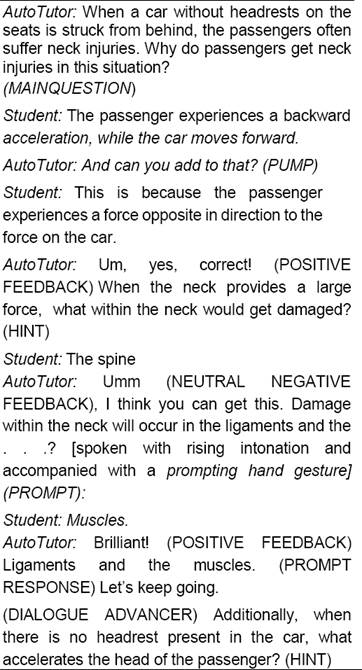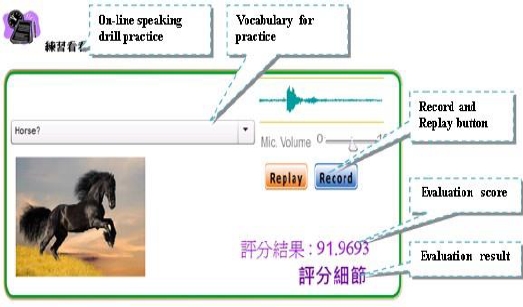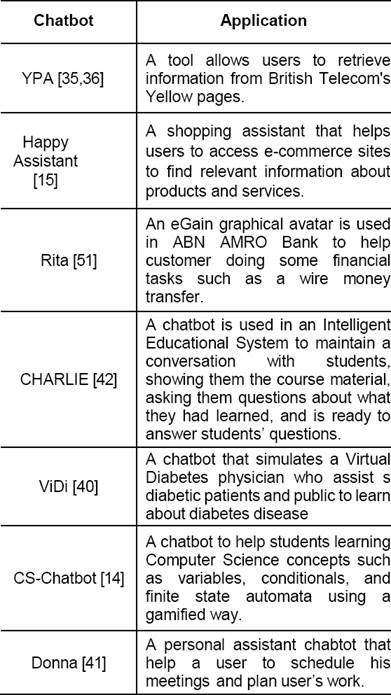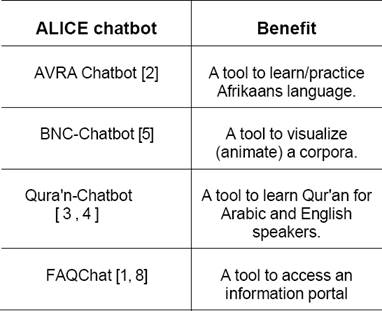1 Introduction
Language Technology is concerned with using computers to do useful things with human languages. In terms of using this technology in teaching languages, teachers look at a computer as a tool to address problems, communicate with students, and keep records and materials. From the students prospective the computer is used to solve problems, access required materials, do home works and obtain feedback [60].
CALL systems are built to facilitate teaching and learning a foreign language using the computers. The learning materials and assessments are presented to user in audio, video, text, and images. On the same manner, learners communicate with the system in textual or speech manner. Due to fast technology development and the rapid internet, learners and teachers are interested in Web-CALL which is “a software that enables language teachers to produce web-based teaching materials and enables students to study them online" [26].
With all types of assessments that are provided by CALL to enhance writing skills, vocabulary, pronunciation and grammar for a learner, CALL system needs to enable a learner to practice the language via speaking with another native partner. To overcome this shortage a chatbot or a conversational agent could be integrated to CALL System as it will be discussed in this paper.
A chatbot is a conversational software agent, which interacts with users using natural language. Developing chatbots started in 1967 when Weizenbaum [53] implemented the Eliza chatbot to play the role of a psychotherapist. Four years later, Colby [19] created PARRY to imitate a paranoid patient. PARRY is considered as a tool to study the paranoia and Eliza as a physiatrist or a “clinical agent” who can serve many patients at the same time [20]. Recently, several chatbots are found and used for different purposes. However, a chatbot is restricted to knowledge base that is hand coded in its brain, which may be an obstacle to use it as an agent for teaching a certain language.
To facilitate chatting on different topics and languages, software was developed to read from a corpus and build knowledge base of a chatbot automatically [5]. The software has been adapted to handle different corpora format such as: dialogue, monologue, and questions answers in different languages. For example, the Qur’an in Arabic and English Corpora, English and Arabic Questions Answers Corpora, British National Corpus (BNC), and Corpus of Spoken Afrikaans has been used to generate different chatbots prototypes using a corpus based approach. Results and feedback gained from users, teachers, and language learners confirm that chatbots could be sued as conversational partners to aid practicing a foreign language.
The remaining sections of this paper are organized as follows. Section 2 describes CALL system and its evolution within years. CALL limitations and suggested solutions are presented in Section 3. Proposing a chatbot as a conversational partner, illustrating different trials of adapting a chatbot to new domains and languages, and integrating chatbot with CALL system are discussed in Section 4. Evaluations and conclusions are clarified in Sections 5 and 6 consequently.
2 CALL History and Evolutions
Computer-assisted language learning (CALL) is “an approach to language teaching and learning in which computer technology is used as an aid to the presentation, reinforcement and assessment of material to be learned, usually including a substantial interactive element”. [56].
CALL system has been evolved within years, where three main distinct stages are noted: behaviouristic CALL, communicative CALL, and integrative CALL as listed below [24, 30]:
Behaviouristic CALL. This phase was in service in the interval 1960-1970 , programmable teaching approach is used in which the computer plays the role of a tutor, who checked students input, allows students do some appropriate exercises, and gives them immediate feedback. This phase has been known as “drill and practice”.
Communicative CALL. The next phase continues from 1970-1980. Teaching in this phase is based on communication such as playing computer games in order to motivate the students to learn new concepts. Many CALL approaches were used such as: computer as stimulus where the critical thinking problems, and conversational exercises were used; and computer as a tool to enhance writing skills in which spelling and grammar check programs were used.
Integrative CALL. This is the interactive approach that starts from 80’s till now, where the internet and the interactive multimedia is used for teaching a language such as text, image, video, audio, and animation.
Levy [39] defines CALL as an interdisciplinary field which has many contributions in teaching languages and has relations with other fields as shown in Figure 1.
According to Levy [39] the target of CALL is to replace the tutor, in which it provides learning materials, then give exercises to learners and provides appropriate feedback. Gimeno-Sanz and Davies [27] listed some of the most common exercises provided by CALL:
— Multiple-choice exercises, which allow learners to select an answer and then a suitable feedback, will be provided.
— Open-input exercises, which allow learners to type an answer. Then the system parses this input to figure out spelling mistakes and provide alternative answers.
— Information gap exercises which are based on the word missing workouts.
On another trend scholars tried to integrate CALL with task-based learning approach (TBL) in which CALL serves as a media to provide the required materials and instructions in audio, text, and sound media, then moves learner to some exercises to measure learner’s understanding. At the end, a textual activity is downloaded with instructions, and students are asked to do it in pairs1.The keyboard, the mouse and speaking into microphone are used to provide responses to CALL exercises.
CALL system can be considered as an online self-learning tool to learn a foreign language at anytime and anywhere without the need for a teacher or a class. Moreover, the system enables students to check their individual progress in target language learning. Kushnir et al., [37] claim that even though computers are capable of providing practice in areas like pronunciation and translations, there are some drawbacks, which sometimes decrease the level of progress. For example, using the approach of symbolic programming in computer aided translation, in which a sentence is divided into minimal chains which are then translated to another language using a previously created database, may result in the incorrect interpretation in the phrase and sometimes erroneous subdivision of the sentence that are hard to catch by the learner. This may leads to incorrect use of these entities.
3 CALL Limitations and Solutions
Zhao [59] reviewed the literature of CALL and concluded the following limitations:
— The settings of instructions where studies were concluded were limited to higher education’s and adult learners;
— The languages studied were limited to common foreign languages and English as a foreign or second language;
— The experiments were often short-term and about one or two aspects of language learning (e.g. vocabulary or grammar).
In order to overcome these drawbacks, the author suggested that maybe the best way to use technology to enhance learning a second language is to develop an effective language learning environment. Such an environment should satisfy the following four conditions:
Accepting inputs on different format such as video, audio, and textual mode.
Delivering high quality feedback that may have different forms such as sound, speech, and text.
Providing multi communication channels such as: forums, video conferences, and enabling learners to interact with conversational agents to practice.
Publishing the learning materials, assessments to allow learners to access anywhere at any time.
An effective language learning environment can support the whole language learning process with all available technology, not only concentrating on special domains such as grammars, vocabulary but uses this environment to help the learner in all aspects of learning [60].
Angelova et al. [11] claimed that CALL is not enough for language learners for many reasons:
— CALL does not support learner-system communication in natural language;
— There is no adequate processing of learner’s language errors;
— There is no adaptive strategy for structuring the tutoring materials in natural language.
Authors of [11] tried to improve CALL by integrating natural language processing and personalized information retrieval into a single unit to build their Scientific Terminology Learning Environment (STyLE) [11, 23]. The system checks the syntactic and semantic correctness of the student input. For instance “John loves Mary” is linguistically correct but does not answer the question “who does trade stocks on the primary market”. Therefore, checking the appropriateness of an answer according to the question is an important issue [11]. STyLE system provides the following facilities for students: reading teaching materials; performing test drills; and discussing each learner model with the system. The system targeted adults who are non-native English speakers with intermediate level of English proficiency and aimed to teach them English financial terminologies [12].
After studying teaching materials, students could try some activities in which STyLE provides some questions for students, then check students’ response in comparison to pre-stored answers, and then the system provides useful feedback for students. It may also guide students to some recommended reading in particular learning situations.
In this context Fujii et al., [26] developed an online language learning environment “Web- CALL”, which "is a software that enables language teachers to produce web-based teaching materials and enables students to study them online" [26]. “Web-CALL” consists of two units Web-page Materials Production Unit (WMPU) and the Learning Support Unit (LSU). WMPU enables teachers to generate learning materials such as questions, answers, hints, and comments. This software allows teachers to use text, sound, pictures, movie files, and incorporate on-line reading, writing and listening exercises. The learning Support unit (LSU) enables students to study online language lessons produced by their teachers. To evaluate “Web- CALL” lesson, the teachers compared “Web-CALL” class with normal traditional teacher oriented class.
A test has been provided to students that consist of four types of questions: comprehension check, grammar as multiple choice questions, grammar as translations questions, and grammar as word orders. Results show that a “Web-CALL” class was superior to a normal class in comprehension and word order. Also a questionnaire distributed to students in “Web- CALL” class presented that 87% students enjoyed “Web-CALL” class, 86% students studied positively, 79% of students understood the lesson, and 85% of students felt they are free to study at their own space.
Golonka et al., [28] listed the following common problems of CALL:
— Poor description of the research design;
— Lack of relevant data about participants;
— Poor choice of variables to be investigated;
— Mostly focusing on Western European Languages, especially English;
— Most studies based on untrained users of technology.
— Poor attention is given to key factors that help to enhance the effectiveness of foreign language learning.
To avoid some of these problems, different techniques and tools were used within the CALL system. For example, Levison and lessard [38] developed VINCI as a natural language generation environment designed for use in CALL. VINCI is “based on a collection of meta languages which define the semantics, syntax, lexicon and morphology of a language” [38]. This system is developed to use different languages, till now it works on English and French. The system generates a story in a specific domain, and then provides some questions to students and compare results with pre-stored answers.
The natural language dialogue systems have been integrated to aid in teaching different materials such as computer concepts [9] or physics. Why2-Atlas [49] is used to teach physics by guiding learners to update their answers through a dialogue between the system and the student. The system is composed of three windows: the problem window which is used to display the question, the essay window through which a student provide an answer as an essay, and finally the chat window.
In the same manner AutoTutor [29] is developed to teach qualitative physics and computer literacy. The system poses problems that need detailed information to answer. After student provides an answer, the system engages the learner in a mixed initiative dialogue that helps the learners to improve their answers. A sample of a conversation (taken from [29]) generated between a student and AutoTutor is shown in Figure 2.
On the same manner many technologies have been integrated to CALL system to enhance the pronunciation learning. For instance, the automatic speech recognition techniques have been integrated into CALL [17, 18]. SPELL [43] is a virtual learning environment of CALL system that enables French students to practice English conversation with virtual characters. PARLING [44] is another version of CALL that uses a story based technique to help the beginner learners of Italian to memorize words in a story.
On another trend, GeCALL system [58] integrates a game based technique within CALL system, to enhance learning the pronunciations in English language. GeCALL system provides two activities: drill and game-based practices. In the drill practice, learners record their voices repeating the sounds that are produced by a native speaker. Immediate scores and feedback for the learners’ utterances appear on the screen as shown in Figure 3.
In the game-based activity, a picture is displayed and the learners can select and pronounce the word from a candidate list. If their answer is correct and the pronunciation is correct, then the learners move to the next question. The game-based approach is composed of four levels, where learners move from one level to another after finishing the previous level correctly. An experiment using GeCALL system was applied on a Taiwan school where 52 students participate in this experiment. Output reveals improvements on students’ pronunciation. Moreover, the game-base activities attract most students especially the low-achievement ones which supports the idea of applying educative game technique for language learners.
4 Chatbots as Conversational Partners
A chatbot is a computer program, which interacts with users using natural language either by textual or verbal chatting. The main aim of chatbots is to mimic human conversation by convincing users that they are talking to real human while in fact they are talking to machines. Chatbots have been used as an assistant tool in many domains as education, health, and e- commerce as presented in Table 1.
A chatbot could be an appropriate partner to practice a language, for example, Wallace et al. [52] proposes using chatbots for reading books for reading books for children, and teaching foreign languages.
In this context Speak2Me.net website is built to help Chinese learners to learn English language. The website includes Lucy chatbot that represent a young British lady where learners can chat with her. Figure 4 shows a sample of chatting with Lucy. Jenny is another chatbot that is used in English2Go.com website to enable learners to practice English via chatting. On the same manner Jabberwacky2 chatbot is used for language practice, where it can learn from all its previous conversations. Robin [46] suggested that learners "could make use of primitive Web-based translation bots, such as Google’s Language Tools or Alta Vista’s Babelfish in a way that would redefine the notion of usable learner input.”
4.1 Retraining an Adaptive Chatbot for New Topics and Languages
ALICE [10, 52] is the Artificial Linguistic Internet Computer Entity, created by Wallace in 1995. The knowledge base of ALICE is stored in AIML files. AIML, or Artificial Intelligence Mark-up Language, is a derivative of Extensible Mark-up Language (XML). It was developed by the Alicebot free software community during 1995-2000 to enable people to input dialogue pattern knowledge into chatbots based on the ALICE free software technology.
AIML consists of data objects called AIML objects, which are made up of units called topics and categories as shown in Figure 5. The topic is an optional top-level element, it has a name attribute and a set of categories related to that topic. Categories are the basic unit of knowledge in AIML. Each category is a rule for matching an input and converting to an output, and consists of a pattern, which represents the user input, and a template, which implies the ALICE robot answer. The AIML pattern is simple, consisting only of words, spaces, and the wildcard symbols _ and *. The words may consist of letters and numerals, but no other characters. Words are separated by a single space, and the wildcard characters function like words. The pattern language is case invariant. The idea of the pattern matching technique is based on finding the best, longest, pattern match. From the language teachers’ point of view the conversation should be in different topics to learn the vocabulary. However, most knowledge base is inserted manually to chatbots including ALICE, which will be hard to readapt to different topics or languages.
To allow different chatting based on different knowledge based, an Automatic AIML Genrator (AAG) software system is developed to read different corpora and convert it into ALICE BOT knowledge base format AIML [5].The generated AIML files are used to build a new prototype of ALICE chatbot that can chat in the language and topic of the training corpus [7]. Abu Shawar and Atwell [6] examined many trials to test the corpus-based approach using dialogue, monologue, and questions/answers corpora. The created prototypes of ALICE were used as tools to: learn Afrikaans language, teach the Qura’n, visulaise a corpus and to retrieve answers for questions. Table 2 presents some of the generated prototypes of ALICE and its benefits.
Kerly et al. [34], found such approach useful as a tool to practice languages even though it is restrictive to the training corpus. Chatbots allow students to practice different language structure and vocabulary including slang and taboo words, which they have little chance to practice [25]. On the same manner, Jia [33] used a modified version of Chatbot for conversational training.
4.2 Integrating CALL System with a Chatbot
Based on the idea of language teachers that the best way to learn a language is through conversation, a challenge is created to integrate conversational partners or chatbots within CALL system, which may overcome some of the CALL limitations related to practicing a language.
On this respect, Wik and Hjalmarsson [54] built Ville as a virtual language teacher whose main role is to improve the language skills for students by using vocabulary and pronunciation training, guiding students, and providing proper feedback to them. Ville was developed to allow learning Swedish as a second language. Three types of exercises were offered to students:
— Perception: Ville says a word and the student identify corresponding picture, listen and click vocabulary exercise.
— Pronunciation: Flashcards were offered to students who can record and playback their recordings.
— Writing: which are spelling exercises where Ville pronounces a word and students are asked to write it down.
Evaluations of 402 students who used Ville show that the system had improved students' pronunciation skills more than writing, and listening skills.
To encourage learners to spend more time with CALL, a role-playing dialogue system was introduced in DEAL. The researchers adopted game design principle "Good gameplay" [45] to keep learner engage with the system for long time in a fun and challenging context. DEAL [55] is considered as a complement to Vile, where Ville acts as a language teacher, DEAL acts a conversational partner with the objective of creating and keeping an interesting dialogue. The trade domain was used in DEAL. Figure 6 shows the interface of DEAL agent, and a dialogue example.
Vlugter and Knott [50] claimed that one conversational partner is not enough to teach personal pronouns, or verb inflections which in some languages must match with the person and number of subject or object. The authors of [50] developed a multi-speaker system to be used in a CALL environment to teach a New Zealand language (Maori).
Danilava [21] introduces the term Artificial Conversational Companion (ACC) for conversational agents that interact in with the user in a natural language. ACC is "a personalized, helpful and persistent conversational agent that knows its owner and interacts with the user over a long period of time" [22] using natural language. The main idea is to deal with an agent who knows about you, and able to serve interests for long time of period. There are many companions such as Senior Companion [57], ALize-E robot companions for children in a hospital environment [13], and Health and fitness Companion [47].
5 Experiments and Evaluations of Using Chatbots as Conversational Partners
During the trials to retrain Alice chatbot with different corpora, and using it for different purposes, The Corpus of Spoken Afrikaans (Korpus Gesproke Afrikaans) [48] has been used to retrain ALICE. The AAG software is used to build the AIML files automatically; some atomic categories related to greetings were added manually, because the corpus does not cover this topic. The generated AIML files were used to generate two Afrikaans chatbots [2]: Afrikaana, which speaks just Afrikaans, and AVRAA which is a bilingual version speaking English and Afrikaans. The two prototypes were published using the pandorabot service and users from South Africa were encouraged to do chatting with them. Based on the received feedback, many responses were either not related to the topic or nonsense. In fact, the following three main factors are behind this result:
— The dialogue corpus does not cover many domains that user chat in.
— The corpus contains more than one speaker in an utterance which is non-trivial to model turn- taking correctly as pattern and template in AIML language [5].
— The adopted machine learning approach used in AAG software does not use any linguistic analysis markup such as: semantic, grammatical, and dialogue act annotation because pattern matching technique in ALICE/AIML makes no use of such linguistic knowledge.
The positive side in this experiment is that users enjoyed chatting and found it an interesting tool to practice a language. Abu Shawar and Atwell [7] concluded from this trial that a chatbot could be used as a tool for unknown languages where the language is either unknown to chatbot/developer or unknown to computational linguistics in terms that there is a shortage in existing tools to deal with this language.
On the same manner, Jia [31] applied an experiment in China using ALICE chatbot to see whether a chatbot can replace a real partner to teach a foreign language. Students from universities and colleges were asked to chat with ALICE, where students only knew that they were chatting with a partner to help them learning English. Unfortunately, vast majority of students realised that they are chatting with a machine after short period of time. As a result 1256 users chatted with ALICE, where 17% wrote positive comments such as: “you are clever”, and “you are nice”; 88% of them chatted for a short time only once; and 24% provided negative feedback. Jia referred this to absence of linguistic knowledge and counting on lexical word matching process without any semantic processes.
Analysis of dialogue generated between users and ALICE reveals that the chatting cover many topics in our daily life, for example, 11.39% of students talked about exams and English study, and 13% mentioned love, most of students who are younger than 30 told Alice some private stories and their emotional problems. Jia [31] concluded that even with only simple key-word matching, a chatbot usage not only limited to act as a learning partner but could be considered as a ”dear friend who may enjoy the joy and suffer the pain of the users”. To overcome the absence of linguistic knowledge information in ALICE, Jia [32] created an intelligent Web- Based system to teach a foreign language.
Even though that responses of most chatbots are redundant, predictable, and lacking in personality as listed by Chantarotwong [16], Fryer and Carpenter [25] assured that a chatbot can be considered as a tool to practice a language anywhere and anytime, especially for non- beginners learners. Using a chatbot for teaching a language is useful in many aspects as illustrated below [25]:
— An amused tool that motivate learning;
— Learners felt more relaxed when chatting with a bot rather than real human partner;
— A chatbot can repeat the same material several times without being bored;
— Many chatbots use texts and speech modality for conversation which are useful to enhance the learners’ communication skills including reading, listening, talking and writing.
6 Conclusion
CALL is presented as a media to teach a foreign language, in which different activities are provided in sound, audio, and images. However, there is a lack in practicing conversation in these programs, which is the preferred way to teach languages. In an attempt to overcome this issue, the current paper presents the need to integrate CALL system with a chatbot to play the role of a conversational partner. Different trials and evaluations that are presented in this paper confirm the enhancements of the language learners’ outcome after using chatbots as conversational partners.











 nova página do texto(beta)
nova página do texto(beta)










